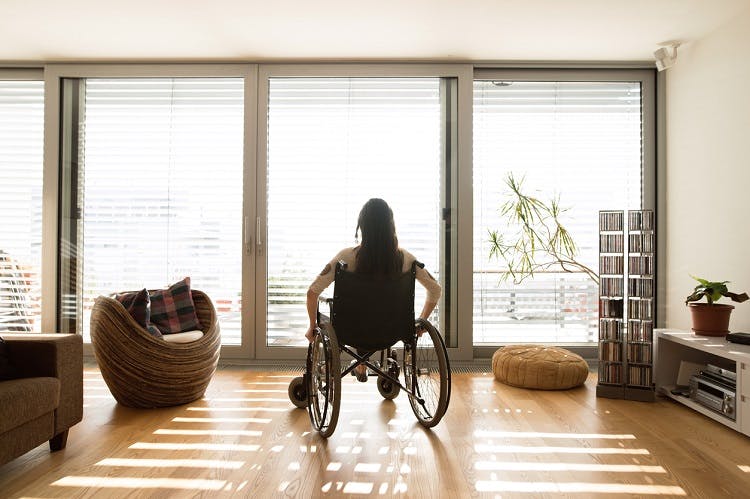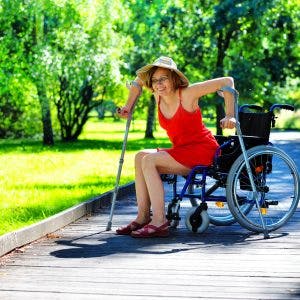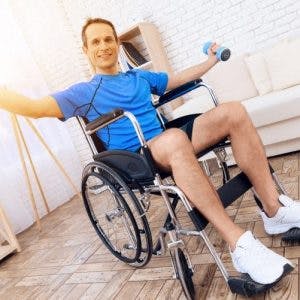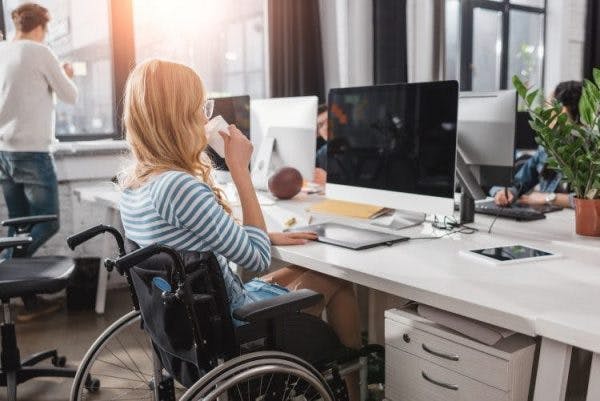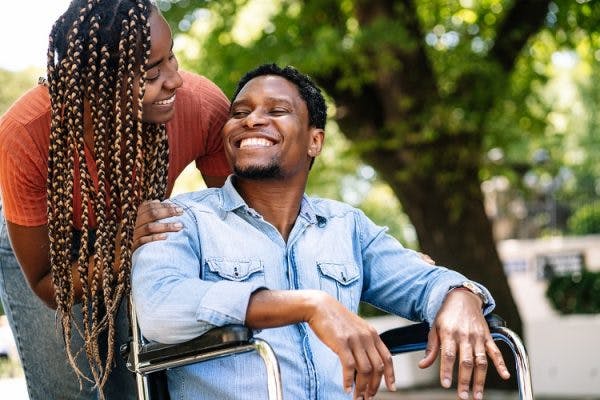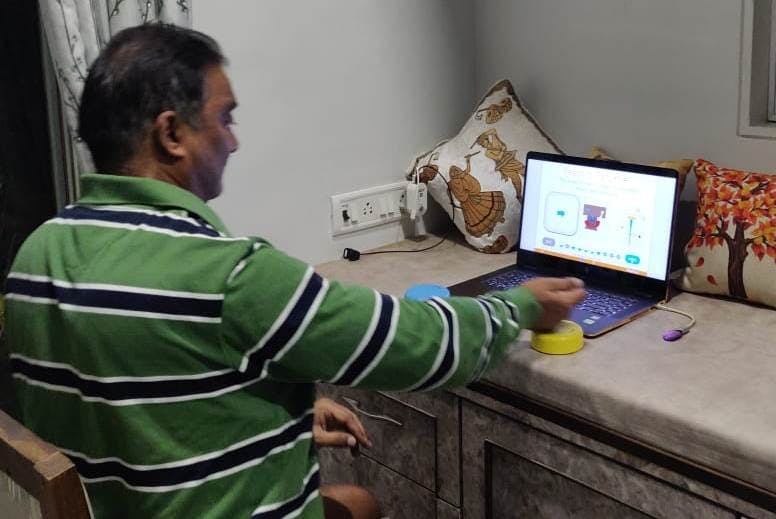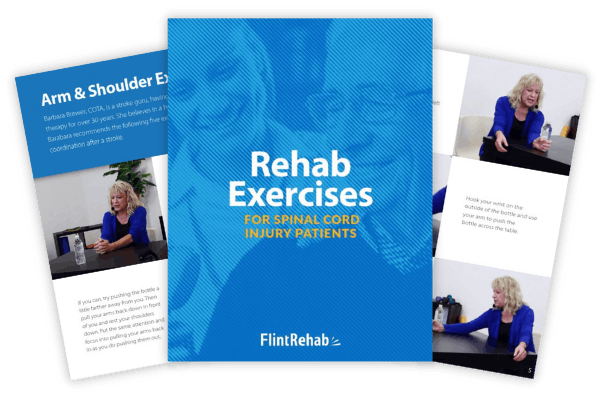When the spinal cord sustains an injury, it can lead to motor and sensory effects such as spasticity (muscle tightness), numbness, or breathing difficulties, just to name a few. When these effects are left untreated, they can progress into more serious spinal cord injury complications.
Thus, it’s important to be aware of the potential complications of spinal cord injury and seek emergency medical attention if new symptoms arise.
This article will discuss what potential spinal cord injury complications can occur and what the underlying causes may be. It will also explore management techniques that can help improve overall health and promote recovery.
Use the links below to jump straight to a particular complication of spinal cord injury:
- Lack of Blood Circulation
- Pain
- Contractures
- Bowel and/or Bladder Dysfunction
- Pneumonia
- Atelectasis
- Bloated Stomach
- Scoliosis
- Pressure Sores
- Osteoporosis
- Heterotopic Ossification
- Weight Gain/Weight Loss
- Leg Swelling
- Sleep Problems
- Depression & Anxiety
What Are the Complications of Spinal Cord Injury?
To prevent spinal cord injury complications from worsening, it helps to understand what they are and how they can occur. It’s especially important to note the risk factors that can increase the chances of developing certain complications.
Be sure to seek emergency medical care if you or a loved one experience any new signs or symptoms after spinal cord injury.
Here are some of the most common spinal cord injury complications that may occur:
1. Lack of Blood Circulation
The spinal cord is responsible for transmitting messages that control movement and sensation throughout the body. When a spinal cord injury affects movement, it can result in paraplegia (paralysis of the legs) or quadriplegia (paralysis of the arms and legs), potentially creating the need for a wheelchair.
When spinal cord injury survivors are unable to move independently and do not participate in regular exercise, stretches or therapy, the lack of physical activity can cause blood to pool in the arms and legs.
As a result, this can disrupt blood vessel tone, and when your blood vessels relax too much, there isn’t enough pressure to efficiently push blood back to the heart. Individuals with poor blood circulation may experience low blood pressure, cold feet, lightheadedness, dizziness, or weakness.
2. Pain
Pain is among the most common complications of spinal cord injury. Specifically, untreated secondary effects of spinal cord injury can result in musculoskeletal and/or visceral pain.
Musculoskeletal pain involves pain in the bones, joints, ligaments, tendons, and muscles. It can stem from unmanaged spasticity (tightness of the muscles) or excessive use of muscles and joints. It can also be caused by dependency on the unaffected areas of the body.
For example, an individual who uses on a manual wheelchair may rely primarily on their arms and shoulders to move around after a spinal cord injury. However, the arm and shoulder muscles are not designed to carry the weight of the full body, and thus the muscle strain from overworking these muscles can result in musculoskeletal pain.
Although less common, spinal cord injury survivors can also experience visceral pain, or internal organ pain. Visceral pain is usually caused by urinary or bowel dysfunction, and individuals generally feel aching or cramping around the abdomen.
A physical therapist is a great resource for treating and preventing musculoskeletal pain after spinal cord injury. Alternative remedies such as acupuncture, massage therapy, and rest may also help reduce pain. You can also talk to your doctor about possible medication for pain depending on the severity.
3. Contractures
A contracture refers to the tightening of affected muscles, ligaments, and tendons. This often occurs when spasticity has not been managed properly, and typically results in limited joint motion and pain. Contractures occur in approximately 66% of individuals with SCI, and may develop in the early stages of spinal cord injury or later in recovery.
Survivors may experience neurally mediated contractures due to unmanaged spasticity, or non-neurally mediated contractures that occur due to immobilization, particularly when muscles remain in shortened positions. For instance, knee flexion contractures usually result from the loss of knee extension for long periods of time.
Contractures not only limit joint mobility but they can also interfere with daily-life activities. Fortunately, physical therapy interventions such as stretching and passive movements can help manage contractures. Working with your physical therapist is essential to receive a variety of stretching and passive exercises for contractures tailored to your ability level.
4. Bowel and/or Bladder Dysfunction
Proper bowel and bladder functioning is necessary to remove waste from the body. When the spinal cord cannot transmit signals to the bowel and bladder muscles, it can lead to bladder and/or bowel dysfunction.
When the bladder muscles are not working, individuals may experience incontinence or be unable to empty the bladder appropriately. If not addressed, bladder dysfunction can cause a variety of more serious complications, including urinary tract infections, kidney stones, and bladder cancer.
Furthermore, when affected bowel functions are not managed properly, other serious complications such as constipation and bowel incontinence may occur. Lack of bowel management can result in additional problems, including abdominal pain, hemorrhoids, anal fissure, and other diseases.
Fortunately, there are ways to help your body get rid of waste and restore proper bowel and bladder functions after a spinal cord injury. This can include lifestyle changes such as increasing your water intake, maintaining a high-fiber diet, performing consistent catheterizations, and using a regularly scheduled bowel management program.
Additionally, medication may be prescribed to help manage complications such as laxatives to promote bowel movement. Be sure to consult with your doctor before taking any medication to see if they are safe for you.
5. Pneumonia
After a spinal cord injury, survivors may not be able to cough strongly enough to get rid of fluids in the airway. This is common after high-level spinal cord injuries, like a C5 (cervical injury), which can result in loss of control over the diaphragm muscle.
When the diaphragm is impaired, it can make it difficult to breathe and cough, which is an important mechanism to clear the airway. Eventually this can lead to respiratory infections such as pneumonia.
Pneumonia occurs when one or both lungs fill with fluid and become infected. Treating pneumonia generally consists of antibiotics, but alternatives such as respiratory muscle exercises during physical therapy may also be recommended by your doctor.
6. Atelectasis
High level spinal cord injuries can also result in other lung complications such as atelectasis, the complete or partial collapse of the lungs due to blocked airways. Atelectasis is often asymptomatic until it affects larger portions of the lungs. When it occurs, survivors may experience shortness of breath, coughing, and chest pain.
Deep breathing exercises as well as using a ventilator or CPAP machine may help increase lung volume. Additionally, coughing exercises can help provide strength to effectively remove mucus from the lungs and help prevent pneumonia.
7. Bloated Stomach
When bowel and bladder dysfunction or an impaired diaphragm are not treated properly, it can cause a bloated stomach. Stomach bloating after spinal cord injury occurs due to gas or water retention in the body. This is an uncomfortable sensation that can make you feel heavy and may even be painful.
To reduce gas and water retention and promote a healthy digestion you can try adjusting your diet, drinking more water, and increasing physical activity when possible. You can also try a bowel program for spinal cord injury to help manage and keep track of stomach bloating.
8. Scoliosis
Another spinal cord injury complication that may occur is scoliosis, a condition in which the spine curves to the side. Although scoliosis typically occurs during adolescence, adults can develop it after traumatic events like a spinal cord injury.
Maintaining good posture while sitting or walking after a spinal cord injury can be difficult, especially when control over the core muscles is impaired. Individuals who continuously compromise their posture and slouch or lean to the side can develop neuromuscular scoliosis if left untreated.
9. Pressure Sores
When most people sit or lay in the same position for an extended period, they start to feel pressure in certain areas of the body and automatically shift positions. However, after a spinal cord injury, survivors may not feel the excess pressure due to impaired sensation and may not feel the need to move for long periods of time.
Too much pressure for long periods of time can disrupt adequate blood flow and deprive tissues of oxygen, making the skin susceptible to pressure sores, especially over bony areas of the body. When treatment is neglected, it increases the risk of additional complications including pain and serious infections. Fortunately, the earlier pressure ulcers are identified, the easier they are to treat.
Additionally, there are ways to minimize the progression of pressure sores. This includes inspecting your skin daily, especially at bony points such as the tailbone, sit bones, ankles, knees, and hips.
You can also ask your caregiver or loved one to provide “pressure reliefs” to reposition your body every two hours when lying in bed or every 30 minutes when sitting up in your wheelchair.
10. Osteoporosis
As previously mentioned, when a spinal cord injury impairs motor control survivors may become less physically active. Lack of physical activity can increase the chances of developing more serious complications, such as osteoporosis.
Osteoporosis occurs when your bones break down faster than the rate at which they are reforming. This causes your bones to become weaker, less dense, and more likely to fracture. Without regular weight-bearing on the affected areas, bone density can decrease, reducing bone strength.
To help lower the risk of osteoporosis after spinal cord injury, make sure you have sufficient calcium and vitamin D in your diet. These nutrients are essential for building and maintaining bone strength.
Another way to reduce the risk of osteoporosis is to gradually add more weight-bearing exercises into your routine to help build bone density. You can also ask your doctor about medications that can help slow down bone breakdown.
11. Heterotopic Ossification
While osteoporosis involves too much breakdown of bone, some complications can occur from the opposite direction: excess bone tissue. Heterotopic ossification, for instance, is an abnormal bone growth in your soft tissues surrounding the joints. This typically occurs below the level of injury, oftentimes in the hip area.
Nearly 20% of spinal cord injury survivors, typically those with more severe injuries, experience heterotopic ossification. This may result in pain and reduced range of motion in the affected areas.
For this spinal cord injury complication, survivors may need prescribed medication. Additionally, if the bone growth prevents joint motion or other bodily functions, it will need to be surgically removed. Other options such as physical therapy or radiation therapy can also be explored.
12. Weight Gain/Weight Loss
Both weight gain and weight loss are common complications of spinal cord injury.
Survivors may lose weight shortly after spinal cord injury due to the decreased levels of physical activity that result in loss of muscle mass (muscle atrophy) and decreased bone density. To help lower the risk of weight loss, it’s important to participate in weight-bearing exercises when possible.
On the other hand, less physical activity also means your body is not using as much energy as it did pre-injury. In order to avoid the complication of weight gain, try to remain active and be mindful of your post-injury diet. Be sure to eat balanced meals and avoid crash dieting. You need plenty of vitamins and minerals, like calcium, to promote recovery and prevent further complications.
13. Leg Swelling
Edema, or swelling, is another spinal cord injury complication caused by the buildup of excess fluid in the body. Leg swelling after spinal cord injury is particularly common in individuals with paraplegia or quadriplegia. Limited mobility decreases blood flow, resulting in excess fluid gathering in the tissues.
Leg exercises, such as passively or actively moving your legs, as well as keeping the legs elevated when possible, can help increase circulation and reduce leg swelling. If your legs become weighted down and difficult to move due to swelling, resistance bands or leg lifters can provide extra assistance to help you move your legs more swiftly.
To help manage leg swelling with paralysis you can also try wearing compression stockings, massaging your legs, and managing sodium intake. Working with a physical or occupational therapist who is certified in lymphedema treatment may also help you manage leg swelling.
14. Sleep Problems
Sleeping after a spinal cord injury is essential to allow the body to heal. However, sleep disturbances after a spinal cord injury may occur due to a variety of factors.
For example, after a spinal cord injury you may struggle with regulating your body temperature, resulting in body temperature dysregulation. Individuals may then feel too hot or cold while sleeping causing them to wake up throughout the night. Sleep disturbances may also be increased by pain, obesity, anxiety, and medication side effects.
There are some management interventions that can help improve your quality of sleep. Effective interventions depend on the primary factors contributing to sleep disturbances. These may include cognitive-behavioral therapy to help identify and reduce anxiety or stress levels, medication for pain, and managing your weight.
15. Depression & Anxiety
A spinal cord injury can bring about sudden changes in daily activities and quality of life, which can be difficult to cope with. Without proper support, survivors may struggle with anxiety or depression after spinal cord injury.
If you or a loved one struggle with depression or anxiety it’s important to reach out to friends, family members, or support groups. You can also speak to your doctor about medication if you are interested. Psychotherapists in particular are another great resource and can provide more insight on psychological care.
How to Treat Spinal Cord Injury Complications
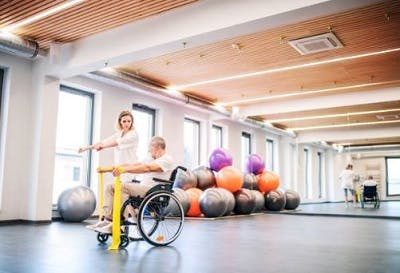
Every spinal cord injury is unique, and the complications that may arise also vary for every survivor. Fortunately, rehabilitation therapy and compensation techniques can help you manage spinal cord injury complications.
For example, to help reduce musculoskeletal pain due to spasticity, you can try physical therapy. With physical therapy exercises, you can improve mobility by activating neuroplasticity (the central nervous system’s ability to rewire itself). As the central nervous system begins to rewire itself and improve communication between the muscles and central nervous system, spasticity may reduce.
While some physical therapy exercises can be challenging depending on your ability level, there are other types of exercises that do not require you to exert as much energy.
For example, rather than using your own strength to move, passive range of motion exercises involve a therapist or caregiver moving your body for you. These exercises encourage the joints to move through their full range of motion, minimizing joint tightness and preventing stiffness.
Occupational therapy focuses on helping survivors maximize independence after spinal cord injury. Exercises focus on attaining the skills needed to complete daily activities such as eating and dressing. Occupational therapists may also encourage survivors to use adaptive equipment to make tasks easier.
Speech therapy can also be helpful, especially for high-level injuries that cause respiratory complications. Speech-Language Pathologists can provide guidance and exercises focused on increasing diaphragmatic strength and managing secretions.
Other methods such as medication can help provide temporary relief from musculoskeletal and visceral pain, as well as respiratory infections and mental health conditions. Consult with your doctor before taking medication because some can cause adverse side effects and may not be ideal for long-term use.
Creating new lifestyle habits after spinal cord injury, such as adopting a healthy diet and being physically active, can help lower the risk of developing complications and may be beneficial to your overall health.
To maintain a well-balanced diet, try to consume nutrient-dense foods that are rich in fiber. This can help increase bulk in your stool and regulate bowel movements. Staying hydrated and drinking plenty of water can soften the stool to help prevent constipation and temperature dysregulation.
Overview of Spinal Cord Injury Complications
Learning how to cope with spinal cord injury complications such as osteoporosis, constipation, pain, and weight loss can require time and patience. Fortunately, you can reduce the chances of developing certain complications by seeking timely treatment.
Thus, it’s important to take note of any new or recurrent symptoms and seek emergency medical attention if you are experiencing new spinal cord injury complications. We hope this article has helped you understand the potential complications that may arise after a spinal cord injury and how to take the proper precautions.

